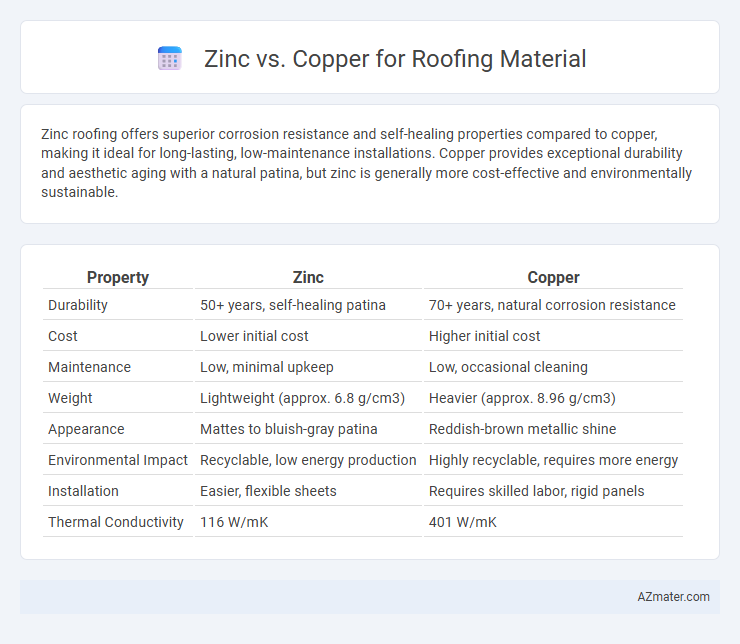Zinc roofing offers superior corrosion resistance and self-healing properties compared to copper, making it ideal for long-lasting, low-maintenance installations. Copper provides exceptional durability and aesthetic aging with a natural patina, but zinc is generally more cost-effective and environmentally sustainable.
Table of Comparison
| Property | Zinc | Copper |
|---|---|---|
| Durability | 50+ years, self-healing patina | 70+ years, natural corrosion resistance |
| Cost | Lower initial cost | Higher initial cost |
| Maintenance | Low, minimal upkeep | Low, occasional cleaning |
| Weight | Lightweight (approx. 6.8 g/cm3) | Heavier (approx. 8.96 g/cm3) |
| Appearance | Mattes to bluish-gray patina | Reddish-brown metallic shine |
| Environmental Impact | Recyclable, low energy production | Highly recyclable, requires more energy |
| Installation | Easier, flexible sheets | Requires skilled labor, rigid panels |
| Thermal Conductivity | 116 W/mK | 401 W/mK |
Zinc vs Copper Roofing: An Overview
Zinc and copper are both durable roofing materials known for their longevity and corrosion resistance, with zinc offering self-healing properties and a matte gray appearance that develops a protective patina over time. Copper roofs provide a distinctive reddish-brown color that alloys to a greenish patina, enhancing aesthetic appeal and weather durability. Maintenance requirements differ as zinc generally needs less frequent upkeep, while copper's higher initial cost is balanced by its strong resistance to harsh environments and recyclability.
Material Properties: Zinc and Copper Compared
Zinc roofing offers superior corrosion resistance and self-healing properties due to its patina formation, which significantly extends its lifespan to 80-100 years. Copper provides exceptional durability with high tensile strength and a unique aesthetic that develops a green patina, lasting over a century with minimal maintenance. Both materials demonstrate excellent malleability for complex roof designs, but zinc is lighter and typically more cost-effective, while copper excels in conductivity and resistance to microbial growth.
Longevity and Durability of Zinc and Copper Roofs
Zinc roofs offer exceptional longevity, typically lasting over 80 years due to their natural patina that protects against corrosion and weathering. Copper roofs also demonstrate remarkable durability, often exceeding 100 years, with their ability to develop a protective green patina that prevents rust and enhances resistance to harsh environmental conditions. Both metals provide superior performance for roofing, but copper's longer lifespan and strength make it a preferred choice for long-term durability in roofing applications.
Aesthetic Appeal: Visual Differences and Patina Effects
Zinc roofing offers a sleek, modern aesthetic with a smooth, matte finish that develops a subtle, uniform patina over time, enhancing its visual appeal with soft blue-gray tones. Copper roofing starts with a bright, warm metallic luster that gradually transforms into a distinctive greenish patina, known as verdigris, which adds a historic and classic charm to buildings. The contrasting patina effects and evolving color palettes of zinc and copper create unique architectural statements, influencing design choices based on desired long-term visual impact.
Installation Methods and Considerations
Zinc roofing requires precise seam techniques such as standing seams or soldered joints, which provide durability and weather resistance but demand skilled labor for proper installation. Copper's installation involves similar standing seam systems but also accommodates more intricate detailing thanks to its malleability, allowing for creative architectural features. Both materials necessitate careful substrate preparation and thermal expansion considerations, with zinc generally expanding less than copper, influencing fastening and joint design during roofing installation.
Maintenance Requirements for Zinc and Copper Roofing
Zinc roofing requires minimal maintenance due to its self-healing patina that repairs scratches and protects against corrosion, reducing the need for frequent inspections or coatings. Copper roofing, while durable, demands regular cleaning to prevent verdigris buildup and inspections to address potential oxidation or structural issues. Both materials offer longevity, but zinc's low-maintenance properties make it an ideal choice for homeowners seeking long-term durability with minimal upkeep.
Environmental Impact and Sustainability
Zinc roofing excels in sustainability due to its long lifespan of up to 100 years and high recyclability, reducing environmental waste and resource consumption. Copper also offers durability and recyclability but requires more energy-intensive mining and smelting processes, resulting in a higher carbon footprint compared to zinc. Both materials resist corrosion and reduce maintenance needs, yet zinc's lower environmental impact and abundant availability make it a more eco-friendly roofing choice.
Cost Comparison: Upfront and Long-Term Expenses
Zinc roofing typically incurs a higher upfront cost than copper due to material and installation expenses, but zinc's lower maintenance requirements can result in reduced long-term expenses. Copper roofs have a higher initial price but offer exceptional durability and a longer lifespan, which may offset replacement or repair costs over time. Evaluating total cost of ownership reveals that zinc is generally more cost-effective in moderate climates, while copper's investment may pay off in harsh environments with its superior resistance to corrosion.
Climate Suitability for Zinc and Copper Roofs
Zinc roofs excel in coastal and humid climates due to their ability to develop a protective patina that resists corrosion and harsh weather conditions, ensuring longevity and low maintenance. Copper roofs perform well in cold and snowy environments because they efficiently shed snow and ice while withstanding freeze-thaw cycles without damage. Both materials offer superior durability, but zinc's natural weathering suits wet climates better, whereas copper's thermal properties favor regions with significant temperature fluctuations.
Choosing Between Zinc and Copper for Your Roof
Zinc roofing offers excellent corrosion resistance and self-healing properties, making it ideal for longevity and minimal maintenance. Copper provides superior durability and an elegant patina that develops over time, enhancing aesthetic appeal while resisting harsh weather conditions. Choosing between zinc and copper depends on budget, desired appearance, and maintenance preferences, with zinc being more cost-effective and copper offering premium durability and visual impact.

Infographic: Zinc vs Copper for Roofing material
 azmater.com
azmater.com